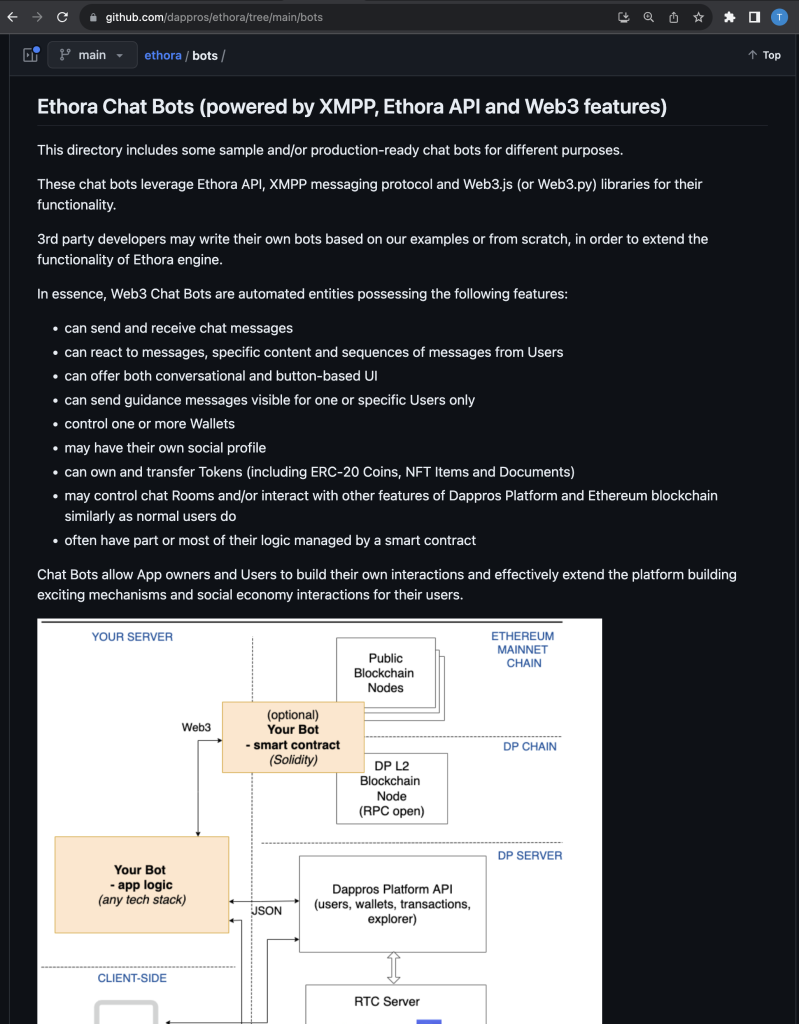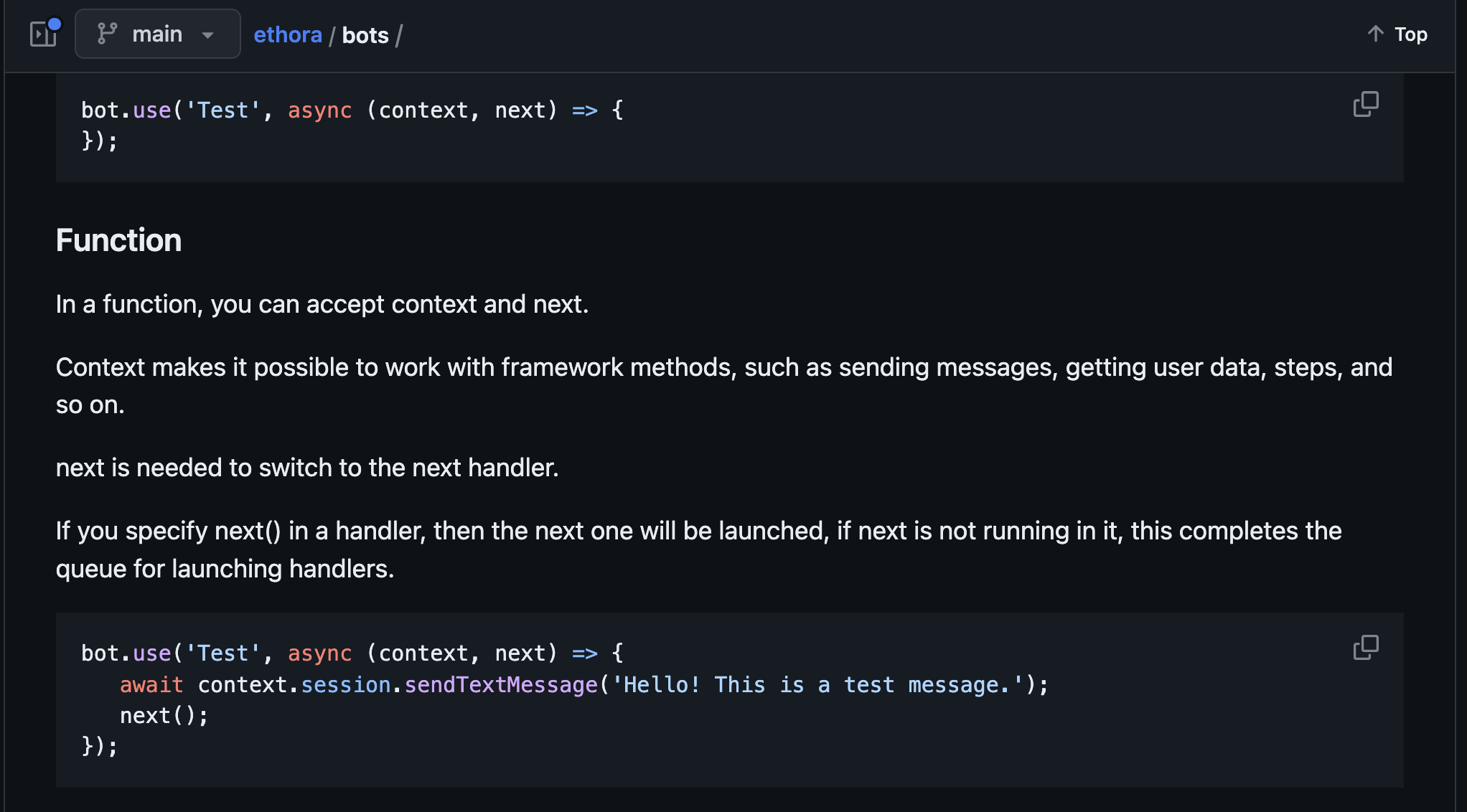Dappros / Ethora team is now happy to publish our Web3 Chat Bots framework. We have been building chat bots for our clients on top of Ethora platform for a while now. In order so that our own developers don’t have to build each new bot from scratch, we have created a sort of SDK which includes core interactions, code classes, documentation and code samples. This means that developers don’t have to spend time on implementing low level things such as XMPP protocol and networking or low-level coding for managing sequences of conversations with Users. This is now taken care of by our Bots Framework.
What is a Web3 Chat Bot? Ethora platform packs many web2.0 and web3 features and surely our Bots also have full access to the web3 features. This means Bots can hold and transfer web3 assets (such as Tokens, Coins, Digital Art (NFT) and Documents), they can sign transactions using their own crypto pair and so on. It is however optional to use all these functions so rest assured you can build a simple chat bot if that’s what you’re after.
Github repo and code samples for web3 chat bots. Our framework and bots examples are published in /bots/ section as part of Ethora monorepository on Github: https://github.com/dappros/ethora/tree/main/bots. We encourage you to visit that page as you will also be able to find the latest documentation and updates on the Ethora Web3 Bots Framework in the readme file there.

Web3 Chat Bots Framework documentation
Below you will find a detailed explanation of the framework. Please refer to Github or our Wiki documentation for the latest version of this.
Getting Started with our Web3 Chat Bots Framework
Framework initialization
To work with bots, you need to connect the framework first.
This can be done as follows: go to our Github repository, then do a git clone in your work directory.
Go to the folder Ethora – Bots – botTemplate
Here you need to run npm run build
Then the “lib” folder will appear. All working framework files will be compiled into this folder.
After doing this, you will be able to use it.
Library connection
To connect to the framework, you need to create a directory for your future bot.
Go to the “bots” folder and create a new directory there where your bot files will be located.
Then go to this folder and create an index.js file – this is the file from which your bot will start.
In the index.js file, include the bot framework like this:
const {Bot} = require(‘../../lib’);
The framework is connected, then, in order to work with your bot, you need to prepare its data.
Create an account for a bot
You can create an account for your bot either manually or automatically.
By choosing the automatic way, the bot will do all the work for you. You will only need to specify the login, password and token.
Create an account automatically
If you want an account to be created automatically, you just need to specify the desired username and password at startup.
If such a login already exists, you will receive a corresponding error. If this login is free, an account will be created and the authorization will be automatically performed.
const data = {
username: ‘Test’,
password: ‘12345678’,
tokenJWT: token
}
For automatic registration, you will need a JWT token – you can get it from this link by copying “Authorization header set to App JWT”:

Create an account manually
Go to the swagger link. Here you need to create a new account for the bot.
1. Copy token JWT

2. Click on the “lock” and paste the token in the “Value” field

3. Click “Try it out” and fill in all fields.
4. Click “Execute”
Connecting a bot
In the index,js file, after connecting the library, create an object with the bot data:
const data = {
username: ‘Username’,
password: ‘Password’,
tokenJWT: ’Token’,
}
(The login, password and token data must be taken from the previous step when creating an account for the bot.)
This is the minimum set of required data to run the bot.
Here is the complete list of attributes you can use:
username: string; – Login when creating a bot account
password: string; – Password when creating a bot account
tokenJWT: string; – The token is in the swager, you used it when creating your account
botName?: string; – The name of the bot, as it will be displayed in chats. (if not specified, the name specified in the application is used)
botImg?: string; – Link to the bot image, if not specified, the default image or from the application will be used.
useAppName?: boolean; – Defaults to true if botName is not specified, the name in the application is used. With false and without botName login is used.
useAppImg?: boolean; – By default, true, the image from the application is used (if the image is not set in the application, the default image is used). If false, the default image or the one specified in botImg.
useInvites?: boolean; – The default is false. If true, then the bot will track incoming invites, and upon receiving an invite, subscribe to the chat room in the invite.
isProduction?: boolean; – The default is true. If ture is used “dxmpp.com” if false “dev.dxmpp.com”.
usePresence?: boolean; – The default is false. If true, then when the user is present in the chat, the corresponding handler will be launched. (more on presence below).
presenceTimer?: number; – The default is 1 minute. Time to run your presence handler.
useRoomsArchive?: boolean; – The default is false. If true, gets the archive of chat rooms and subscribes to them.
connectionRooms?: string[]; – List of chat rooms to which the bot will connect at startup by default, in the format “fb9cf8277d7133ef03aed5811bc5f57237ebddecea351d8abfcb8899f6b56d79@conference.dev.dxmpp.com”
Now you can create a bot, for this it is enough to pass the data we just collected to it:
const bot = new Bot(data);
bot.use(async (ctx) => {
//Sending a message
return await ctx.session.sendTextMessage(‘Hello! This is a test message.’);
}, 1);
Working Process
Handlers
There are handlers you need to create for specific functions that you can use at will – for example, presence in the framework.
Otherwise, you should use the default handler.
Default Handlers
bot.use(‘pattern’, async (context, next) => {
return next();
});
The handler takes three arguments:
1. Pattern (filter by which the bot will check the user’s message) – optional
2. Function (what your handler will do; you create this function) – mandatory.
3. Handler step (you can use steps in your bot to understand where the user is now)
Pattern
In a pattern, you can use various processing options.
The pattern is intended to use it to filter the received user text and run a specific processing only if the message is equal to the pattern.
Emptiness
An empty pattern: you can simply leave it out, in which case the handler will always run when it receives a message.
(this is a good solution when you use the stepper to filter handlers)
bot.use(async (context, next) => {
});
RegExp
You can use regular expressions to filter the text sent by the user.
If the text in the user’s message is equal to your regular expression, the handler will be started.
bot.use(/\/start (.+)/, async (context, next) => {
});
(The handler will run if the message starts with “/start”)
Keywords
This pattern will search the text of the message sent by the user for the keywords you specify.
The handler will work only if the message text contains all the keywords that you specify (regardless of letter case and word order).
In order to use this pattern, you need to pass the keywords in this form “_key_ Test Word” – in this example, the text will be searched for the words “test” and “word”.
Thus, you can specify as many keywords as you like, you need to specify them with a space, without commas.
bot.use(‘_key_ Test Word’, async (context, next) => {
});
String
This pattern takes a string and checks the user’s message for a full match to that string.
For example, when you specify “Test” the handler will only work if the user writes “Test” in the chat.
bot.use(‘Test’, async (context, next) => {
});
Function
In a function, you can accept context and next.
Context makes it possible to work with framework methods, such as sending messages, getting user data, steps, and so on.
next is needed to switch to the next handler.
If you specify next() in a handler, then the next one will be launched, if next is not running in it, this completes the queue for launching handlers.
bot.use(‘Test’, async (context, next) => {
await context.session.sendTextMessage(‘Hello! This is a test message.’);
next();
});
Step
You can specify a “step” handler followed by a user step. After that, the handler will be launched only when the user is currently on the handler step.
The step can be specified both in the format of numbers and in the format of a string.
bot.use(‘Test’, async (context, next) => {
await context.session.sendTextMessage(‘Hello! This is a test message.’);
next();
}, 1);
Stepper
Introduction
The stepper helps to save, modify and delete steps for handlers and users.
Owing to the stepper, you can create different levels of processing for users of their messages and build scenarios for the behavior of the bot.
You can assign a different step to each handler, the step must be unique.
Assigning a step to a handler is optional.
You can name the step as you like, with numbers or a string.
Transitions between steps will work the same way in both cases.
Handler steps have several parameters:
interface IStepData {
stepName: string | number;
onStep: boolean;
editing: boolean;
}
stepName – is the name of the step you wrote.
onStep – automatically set to “true” when the user enters this step, and “false” when leaving this step.
When the user moves from one step to the next.
The previous step is assigned the status “editing” to “true” – thanks to this, when the user gets to the same step again, by looking at the value of “editing” you can find out the first time the user is on this step or the next one.
Each user also has a “userStep“, which you need to assign manually.
It depends on this, when receiving the next message from the user, to which handler with which step to send it.
User step control
To work with steps, you will generally only need these methods.
They allow you to get, delete and edit a user’s step.
nextUserStep
nextUserStep(): void;
The method does not accept incoming data. It automatically replaces the user’s step with the next one (by the step index in the handler steps array).
If the user has not yet set the current step, it will be created (1 step from the array of handler steps).
bot.use(‘_key_ Test’, async (ctx) => {
await ctx.session.sendTextMessage(
‘Congratulations, you have moved to step 1, write something.’);
//User transition to the next step
ctx.stepper.nextUserStep();
});
previousUserStep
previousUserStep(): void;
This method is similar to the previous one, but it changes the user’s current step to the previous one by its index.
If the user does not have a step, it is created automatically.
bot.use(‘_key_ Test’, async (ctx) => {
await ctx.session.sendTextMessage(
‘Congratulations, you have moved to previous step’);
//User transition to the previous step
ctx.stepper.previousUserStep();
});
setNextUserStep
setNextUserStep(step: string | number): void;
The method allows you to manually change the user’s step.
The argument takes the name of the step to which you wish to change the current user step.
bot.use(‘_key_ Test’, async (ctx) => {
await ctx.session.sendTextMessage(
‘Congratulations, you have moved to previous step’);
//Set new user step
ctx.stepper.setNextUserStep(2);
});
removeNextUserStep
removeNextUserStep(): void;
This method doesn’t take any arguments, just removes the user’s step.
This can be useful if you want to move the user to the 0 point of the conversation, before specifying the steps.
bot.use(‘_key_ Test’, async (ctx) => {
await ctx.session.sendTextMessage(
‘Okay, back to the main menu.’);
//Zeroing a step for a user
ctx.stepper.removeNextUserStep();
});
getUserStep
getUserStep(): string | number | undefined;
The method allows getting the user’s current step.
bot.use(‘_key_ Test’, async (ctx) => {
//Get user step.
const userStep = ctx.stepper.getUserStep();
await ctx.session.sendTextMessage(`Your step: &{userStep}.`);
});
Handler steps control
Here you can find methods for working with handler steps.
Handler steps are handled automatically, so you don’t have to use this documentation category.
Only if you want to expand the existing functionality.
addStep
addStep(step: string | number): void;
The method allows you to add your step to the list of steps of handlers.
The argument takes only the name of the step.
bot.use(‘_key_ Test’, async (ctx) => {
ctx.stepper.addStep(“stepTwo”);
});
addStepList
interface IStepData {
stepName: string | number;
onStep: boolean;
editing: boolean;
}
addStepList(steps: IStepData[]): void
The method is similar to the previous one, but it saves not one step, but an array of handler steps.
Now this method is used automatically, after the formation of a step map from handlers.
bot.use(‘_key_ Test’, async (ctx) => {
const stepList = [
{stepName: 1, onStep: false, editing: false},
{stepName: 2, onStep: false, editing: false},
];
ctx.stepper.addStepList(stepList);
});
getCurrentStep
interface IStepData {
stepName: string | number;
onStep: boolean;
editing: boolean;
}
getCurrentStep(): IStepData | void;
The method returns the data of the current step of the handler. It searches for the current step in the list of steps. The method understands that this is the current step by its parameter “onStep” – if “onStep” = “true”, then this step is the current one
bot.use(‘_key_ Test’, async (ctx) => {
const currentStepData = ctx.stepper.getCurrentStep();
console.log(currentStepData)
});
findStep
interface IStepData {
stepName: string | number;
onStep: boolean;
editing: boolean;
}
findStep(step: string | number): IStepData | undefined;
The method will allow you to find the data of the handler step by the name of this step.
bot.use(‘_key_ Test’, async (ctx) => {
const stepData = ctx.stepper.findStep(2);
console.log(stepData);
});
setOnStep
interface IStepData {
stepName: string | number;
onStep: boolean;
editing: boolean;
}
setOnStep(step: string | number, status: boolean): IStepData | undefined;
With this method, you can set the “onStep” status to true or false to the handler step you specify.
bot.use(‘_key_ Test’, async (ctx) => {
ctx.stepper.setOnStep(‘step5’, true);
});
setStepEditing
interface IStepData {
stepName: string | number;
onStep: boolean;
editing: boolean;
}
setStepEditing(step: string | number, status: boolean): IStepData | undefined;
The method is similar to the previous one, it allows you to change the “editing” status of the handler step.
bot.use(‘_key_ Test’, async (ctx) => {
ctx.stepper.setStepEditing(‘step5’, true);
});
changeStep
interface IStepData {
stepName: string | number;
onStep: boolean;
editing: boolean;
}
changeStep(data: IStepData): IStepData | undefined;
The method allows you to change all the data of the selected step at once, for this you need to pass the correct name of the step in the object.
bot.use(‘_key_ Test’, async (ctx) => {
const stepData = {
stepName: 2;
onStep: true;
editing: false;
}
const newStepData = ctx.stepper.setStepEditing(stepData);
});
getAllSteps
interface IStepData {
stepName: string | number;
onStep: boolean;
editing: boolean;
}
getAllSteps(): IStepData[];
The method allows you to get all the steps of the handlers in an array.
bot.use(‘_key_ Test’, async (ctx) => {
const allStepsList = ctx.stepper.getAllSteps();
console.log(allStepsList);
});
Sending messages
For sending messages there is a method which is in “session” – “sendTextMessage”.
This method accepts the text you want to send, as well as a keyboard.
The keyboard is optional.
The keyboard is an array of buttons that has the following type:
export interface IKeyboardButton {
name: string;
value: string;
notDisplayedValue: string;
}
bot.use( async (ctx) => {
const keyboard = [{
name: ‘Close’,
value: ‘Close’,
notDisplayedValue: ‘close’
}];
await ctx.session.sendTextMessage(‘Hello! This is a test message.’, keyboard);
});


